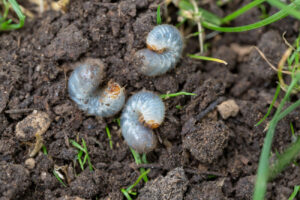June & July Are The Best Time To Treat Grubs
Read MorePosted on: Jun 02, 2022Luis M Pérez
In June and July, it is important to treat for grubs. This is because the June Bugs are out flying around and laying eggs in lawns, and these eggs hatch into larvae known as grubs. Grubs can cause significant damage to your lawn by chewing up the roots of the grass. Additionally, this problem is exacerbated by animals that feed on the grubs. Because grubs eat the roots of the grass, animals often rip up your lawn like a carpet afterward.

The Best Time To Control Grubs
Grubs are seen in lawns as early as April, so why do we suggest treating in June/July? The reason is that this is when grubs are actively feeding. The way grub control works are that when we apply the treatment to your lawn, and you water it in, the grass sucks up and takes in the grub control. Then, when the grub begins feeding on the lawn, it dies. Therefore, treating for grubs in April when the grubs are not feeding is a complete waste of time. Plus, when they are not feeding, they are not causing damage anyway, so there is no point.
What Should You Look For On Your Lawn?
- Irregularly shaped brown patches of dead grass
- Holes in your lawn caused by birds and other animals digging in the grass
- Grass with no roots
- A spongy feeling when you walk on the lawn
Are Animals Digging In Your Yard?
If you are one of the unlucky homeowners who woke up to find animals digging up your lawn this spring, you are not alone. Each spring, thousands of homeowners face this same problem. Raccoons, skunks, birds, and other animals will dig into your lawn to feed on grubs. The best way to prevent this is to treat for grubs yearly. Don’t wait until you already have a problem.
How To Confirm You Have A Problem
While they may be unpleasant, a few are a natural part of any lawn. To determine whether they are causing your lawn issues, look underneath the surface by lifting one square foot section of sod two inches deep with a spade where the dead grass meets the green grass. Look for C-shaped bugs with legs on the inside of the body near the head. If you find 5 to 10 grubs, they are likely causing your lawn issues, and you need to take action to remove them. Feel free to reach out to Dr. Green so we can determine that you have grubs.
Seed, Fertilize And Aerate To Prevent Grub Damage
A thick and healthy lawn is your best defense against grubs. Dr. Green recommends that by seeding and fertilizing your yard, you can repair any damage they have created and prevent new ones from laying more eggs.
In the spring and fall, rake away dead grass from any brown patches. Water your lawn, then sprinkle new grass seed over any thin or dead areas. After reseeding, fertilize the lawn to help the new grass grow. It’s also good to keep your grass about 2 to 4 inches long, depending on your grass type.
Lawn aeration helps prevent grub damage by thickening the lawn and strengthening the roots of the grass.
Want To Learn More? Do You Have any Questions?
To learn more, visit us online at doctorgreen.com, email me at luisp@doctorgreen.com, or 800-465-2934.

